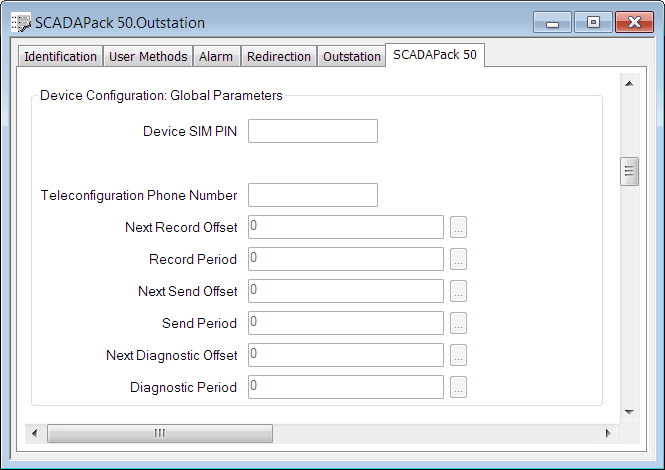Use the fields within the Device Configuration:Global Parameters section on the SCADAPack 50 tab to specify:
- Where the device should send responses to configuration changes
- How frequently the device should record data
- How frequently the device should send data and diagnostic messages to ClearSCADA or a remote destination.

- Device Sim PIN—Enter the PIN code that unlocks the device modem SIM card.
NOTICE
INOPERABLE DEVICE
Enter a valid Device Sim PIN. An invalid PIN will stop communication between ClearSCADA and the device. The device modem will shut down.Failure to follow these instructions could critically affect the operation of the device. To restore operation, a site visit may be necessary. - Teleconfiguration Phone Number—Enter the telephone number to which the device should send responses to a configuration change. If you do not specify a telephone number, the device will send responses to the telephone number from which ClearSCADA sent the configuration change. Proceed carefully when you change this telephone number, if there are outstanding responses due from the device.
- Next Record Offset— Specify the time when the device should next record point data. Enter the time as an offset of the present time. Enter the required interval in the OPC Time Format. You can enter the value directly in the field, or use the Interval window (accessed via the field's browse button) to specify the required value.
Example:
The current time might be 09:55. The current hour is therefore 09.00. You might want to set the Next Record time as 10:30. You would therefore enter 1H 30M as the offset. That is, 1 hour and 30 minutes in advance of (or offset from) 09.00.
- Record Period—Specify how frequently the device should record data from each of its points. Enter the required interval in the OPC Time Format. You can enter the value directly in the field, or use the Interval window (accessed via the field's browse button) to specify the required value.
Example:
If you enter 2H then the device will record data from each point, once every 2 hours.
The start time for the Record Period is determined by the Next Record Offset time.
- Next Send Offset—Specify the time when the device should next send an SMS message to ClearSCADA or to a remote destination. This needs to be a time when the device is already awake to record data (see Record Period and Next Record Offset). Enter the time as an offset of the present time. Enter the required interval in the OPC Time Format. You can enter the value directly in the field, or use the Interval window (accessed via the field's browse button) to specify the required value.
Example:
The current time might be 13:55. The current hour is therefore 13:00. You might want to set the Next Send Offset time as 15:30. You would therefore enter 2H 30M as the offset. That is, 2 hours and 30 minutes in advance of (or offset from) 13.00.
- Send Period—Specify how frequently the device should send data SMS messages to ClearSCADA or to a remote destination. Enter the required interval in the OPC Time Format. You can enter the value directly in the field, or use the Interval window (accessed via the field's browse button) to specify the required value.
Example:
If you enter 12H in this field, then the device will send data SMS messages once every 12 hours.
The Send Period should be the same as, or an exact multiple of, the Record Period. This is so that the device can record point data and send SMS messages in the same device awake period.
Example:
You could set the Record Period at 3 hours and the Send Period at 9 hours. In this case, the Record Period and the Send Period will coincide once every 9 hours, when the device is awake.
The start time for the Send Period is determined by the Next Send time.
- Next Diagnostic Offset—Specify the time that the device should next send a diagnostic SMS message. This needs to be a time when the device is already awake to record data (see Record Period and Next Record). Enter the time as an offset
of the present time. Enter the required interval in the OPC Time Format. You can enter the value directly in the field, or use the Interval window (accessed via the field's browse button) to specify the required value.
Example:
The current time might be 15:55. The current hour is therefore 15:00. You might want to set the Next Diagnostic Offset time as 20:30. You would therefore enter 5H 30M as the offset. That is, 5 hours and 30 minutes in advance of (or offset from) 15.00.
- Diagnostic Period—Specify how frequently the device should send diagnostic messages to ClearSCADA or to a remote destination. Enter the required interval in the OPC Time Format. You can enter the value directly in the field, or use the Interval window (accessed via the field's browse button) to specify the required value.
Example:
If you enter 12H in this field, then the device will send diagnostic messages once every 12 hours.
The Diagnostic Period should be the same as, or an exact multiple of, the Record Period and the Send Period. This is so that the device can record point data and send data and diagnostic messages in the same device awake period.
Example:
You could set the Record Period at 3 hours, the Send Period at 9 hours and the Diagnostic Period at 18 hours. In this case, the Record Period, Send Period and the Diagnostic Period will coincide once every 18 hours, during a device awake period.
The start time for the Diagnostic Period is determined by the Next Diagnostic Offset time.